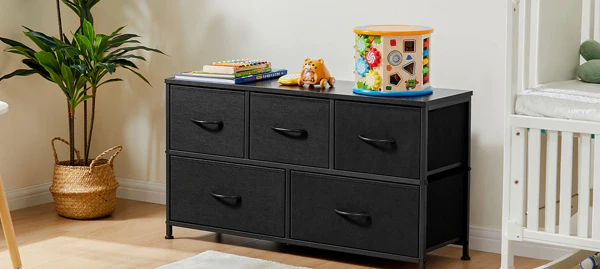Modern living demands furniture that serves multiple purposes while maintaining aesthetic appeal, and few pieces accomplish this better than a well-designed storage dresser. These versatile furniture pieces have evolved far beyond their traditional role as simple clothing repositories, transforming into sophisticated organizational systems that can enhance any room’s functionality and style. Understanding the various aspects of storage dresser selection, placement, and utilization can dramatically improve your home’s organization while creating beautiful, functional spaces.
Understanding Storage Dresser Fundamentals
A storage dresser represents the perfect fusion of form and function, combining traditional furniture craftsmanship with modern organizational needs. Unlike basic dressers that focus primarily on clothing storage, a contemporary storage dresser incorporates multiple compartment types, varying drawer sizes, and often includes additional features such as open shelving, cabinet spaces, or specialized organizational inserts.
The evolution of storage dresser design reflects changing lifestyles and living spaces. Today’s models often feature mixed storage solutions that can accommodate everything from folded garments and accessories to electronics, books, and decorative items. Many contemporary storage dresser units include fabric drawers that provide flexibility for different storage needs while maintaining a cohesive appearance.
Construction quality plays a crucial role in storage dresser performance and longevity. Premium models typically feature solid wood or high-quality engineered wood construction with reinforced joints and smooth-operating drawer slides. The integration of metal frames in some designs provides additional structural support while allowing for lighter-weight construction that doesn’t compromise durability.
Design Options and Style Considerations
The aesthetic impact of a storage dresser extends well beyond its organizational capabilities, serving as a significant design element that can define or complement a room’s overall style. Modern storage dresser designs range from sleek minimalist pieces with clean lines and neutral colors to more ornate traditional styles featuring decorative hardware and rich wood finishes.
Color selection for a storage dresser should consider both current decor and long-term flexibility. Neutral tones such as white, gray, and natural wood finishes offer versatility that adapts to changing design preferences, while bold colors can serve as statement pieces that anchor a room’s color scheme. Many manufacturers now offer storage dresser options in multiple color variants, allowing homeowners to select pieces that perfectly complement their existing furniture and decor.
The size and proportion of a storage dresser must harmonize with the room’s scale and other furniture pieces. Tall, narrow storage dresser units work well in smaller spaces or rooms with high ceilings, while wider, lower profiles suit rooms where horizontal lines are preferred or where the dresser might serve dual purposes such as supporting a television or serving as a display surface.
Hardware selection significantly impacts both the functionality and appearance of a storage dresser. Contemporary designs often feature sleek, minimalist handles or even handleless designs with push-to-open mechanisms, while traditional styles might incorporate decorative knobs or pulls that complement the overall aesthetic. The choice of hardware can transform the same basic storage dresser into pieces suitable for dramatically different design schemes.
Maximizing Storage Capacity and Organization
Effective utilization of a storage dresser requires strategic planning and organization systems that maximize every available space. The key to successful storage dresser organization lies in understanding the different types of items being stored and matching them to appropriate drawer sizes and configurations. Larger drawers work well for bulky items such as sweaters or bedding, while smaller compartments excel at organizing accessories, undergarments, or small personal items.
Drawer organization systems can significantly enhance the functionality of any storage dresser. Dividers, bins, and specialized inserts help maintain order within drawers while making it easier to locate specific items quickly. Many storage dresser models now include adjustable dividers or removable organizers that can be customized to meet changing needs over time.
Vertical space utilization represents another crucial aspect of storage dresser efficiency. The top surface of a storage dresser provides valuable real estate for frequently used items, decorative objects, or even electronic equipment. However, this space should be used thoughtfully to maintain the piece’s aesthetic appeal while ensuring easy access to the drawers below.
Seasonal rotation strategies can help maximize the effective capacity of a storage dresser by ensuring that frequently used items remain easily accessible while seasonal or rarely used items are stored in less convenient locations. This approach allows a single storage dresser to serve multiple functions throughout the year while maintaining organization and accessibility.
Placement and Room Integration
The strategic placement of a storage dresser can significantly impact both its functionality and the overall flow of a room. Traditional bedroom placement remains popular, but modern storage dresser designs are equally suitable for living rooms, entryways, home offices, or even kitchens where additional storage and counter space are needed.
In bedrooms, a storage dresser often serves as a focal point while providing essential clothing storage. Placement considerations include ensuring adequate clearance for drawer operation, maintaining traffic flow patterns, and positioning the piece where it complements other furniture arrangements. Many homeowners find that placing a storage dresser opposite the bed creates visual balance while maximizing accessibility.
Living room integration of a storage dresser requires careful consideration of the piece’s proportions and style compatibility with existing furniture. A well-chosen storage dresser can provide hidden storage for games, electronics, or seasonal items while serving as a media console or display surface. The key is selecting a piece that complements rather than competes with other major furniture pieces in the space.
Material Selection and Durability Factors
The construction materials used in a storage dresser directly impact its durability, appearance, and price point. Solid wood construction offers superior longevity and the ability to refinish or repair the piece over time, but typically comes with a higher initial cost. Engineered wood products can provide excellent durability at more affordable price points while offering consistent appearance and dimensional stability.
Metal components in storage dresser construction, particularly in drawer slides and structural elements, contribute significantly to long-term performance. Quality metal drawer slides ensure smooth operation over thousands of cycles, while reinforcing frames can provide additional structural support for heavily loaded drawers.
Finish quality affects both appearance and maintenance requirements for a storage dresser. High-quality finishes resist scratches, stains, and moisture damage while maintaining their appearance over time. Some finishes also offer easy cleaning and maintenance, which can be particularly important in high-use areas or households with children.
Investment Considerations and Long-term Value
Purchasing a storage dresser represents a significant furniture investment that should be evaluated based on both immediate needs and long-term value. Quality construction and timeless design elements contribute to pieces that remain functional and attractive for many years, making them excellent long-term investments.
The versatility of a well-chosen storage dresser adds to its long-term value by allowing it to serve different functions as household needs change. A piece that works well in a master bedroom might later serve effectively in a guest room, home office, or even as a dining room sideboard, extending its useful life and maximizing the return on investment.
Maintenance requirements should factor into storage dresser selection decisions. Pieces that require minimal maintenance while maintaining their appearance offer better long-term value than those requiring frequent refinishing or repair. Understanding the care requirements for different materials and finishes helps ensure that your storage dresser investment continues to provide value for years to come.
A thoughtfully selected storage dresser becomes more than just a furniture piece; it evolves into an integral component of your home’s organizational system while contributing to the overall aesthetic appeal of your living spaces. The combination of practical storage solutions with attractive design makes these pieces essential elements in creating well-organized, beautiful homes that adapt to changing needs over time.




